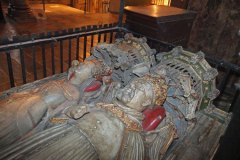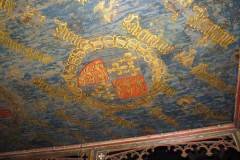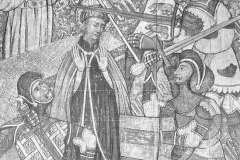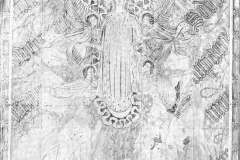This is Canterbury’s only tomb of a monarch. It holds the remains of Henry IV (1336-1413) who reigned 1399 until his death, and his second wife the Queen Consort Joan of Navarre (1370-1437) – for more on Henry’s life and claim to the throne see his biography. Aged 33 at her wedding, Joan became the oldest Queen Consort to marry a monarch – a record she took from Eleanor of Aquitaine and almost lost to Wallis Simpson. Henry and Joan both have alabaster likenesses which are thought to be realistic. They were designed by Richard Beke and probably created by the Derbyshire firm Pentys and Sutton. They were erected sometime in the 1420s or 1430s (sources differ). Henry’s choice of Canterbury as his resting place was known at an early date – it is recorded in his first will of 1409. His reasons are a matter of debate but must surely have included his close association with St Thomas – he was anointed at his coronation service with a phial of holy oil allegedly received by Thomas Becket from the Virgin Mary. There is some irony in the close proximity of Henry’s tomb with that of his uncle the Black Prince, whose son (Richard II) Henry supplanted. Henry died in the Jerusalem chamber of Westminster, supposedly fulfilling a prophesy that he would ‘die in Jerusalem’. The tomb was opened up in 1832 to check its contents. Henry’s features were amazingly well preserved – including his thick matted beard of a deep russet colour.
What to see:
- two fine alabaster figures with matching canopies (Image 1)
- the king’s wide sleeved-tunic known as a dalmatic, with its embroidered borders and side-slits for pockets
- his mantle with its clasp (known as a morse)
- his (and her) crown of oak leaves and fleurs-de-lys
- the Queen dressed in a costume known as a cotehardie, with scaly creatures at her feet
- the SS collars worn by both figures
- the mutilated wooden canopy bearing coats of arms and mottos of the king (Soverayne) and queen (A temperance) (Image 2)
- images at the head (martyrdom of Thomas Becket) and foot (coronation of the Blessed Virgin) of the tomb (Images 3 and 4)
Sources: see standard cathedral sources; also Saul (2011); Hilliam (1998); images of paintings at foot and head of tomb are from Tristram (1951)
NOTE: to hear a Cathedral Podcast on the tomb of Henry IV click here




